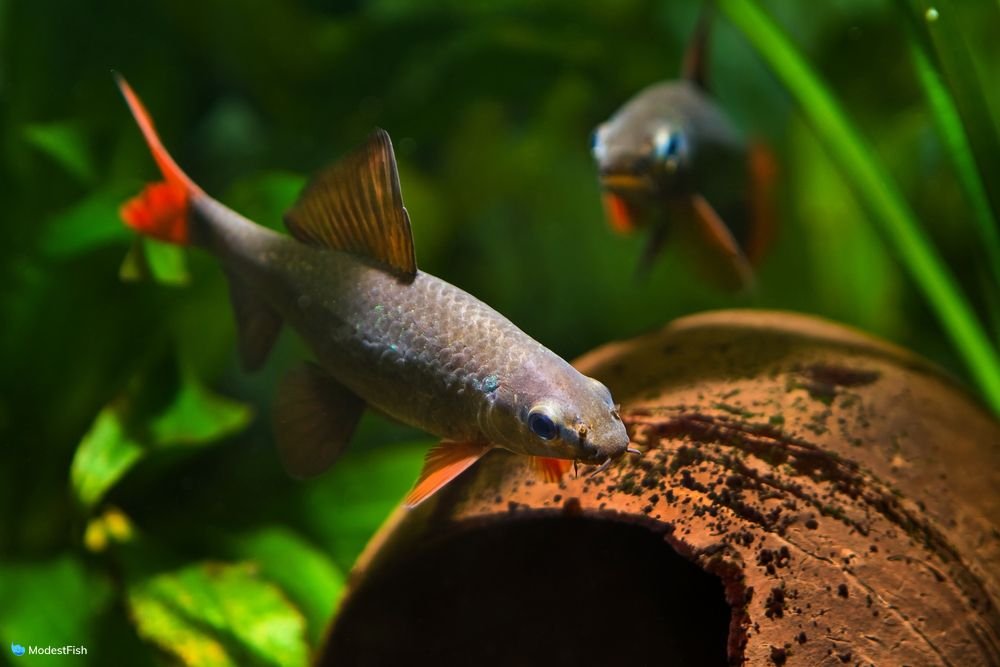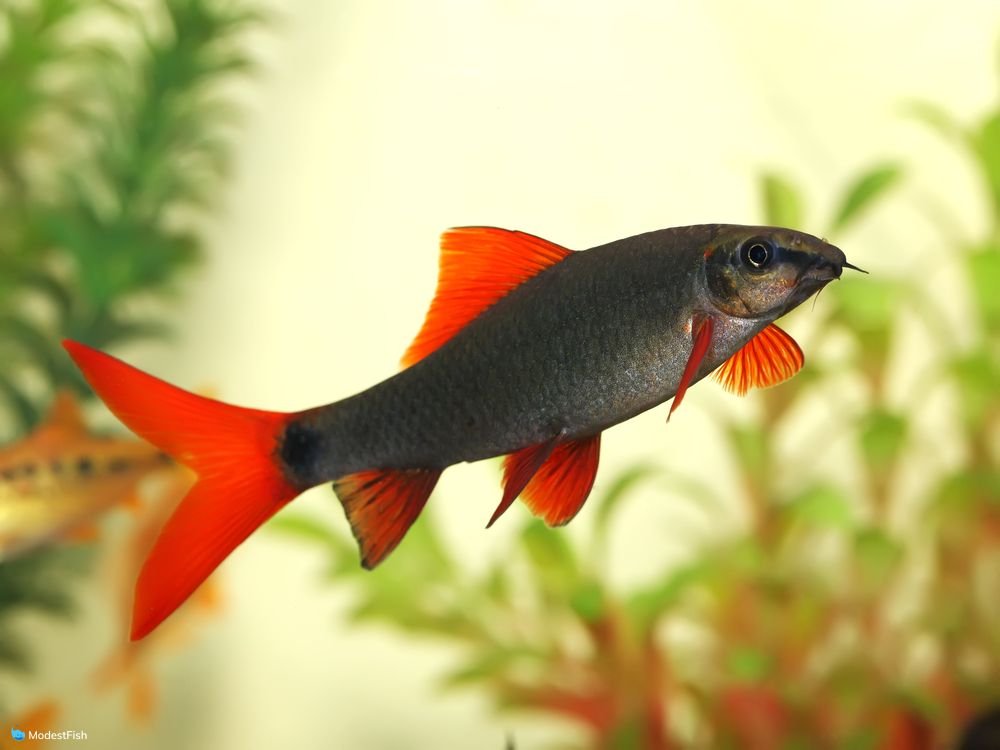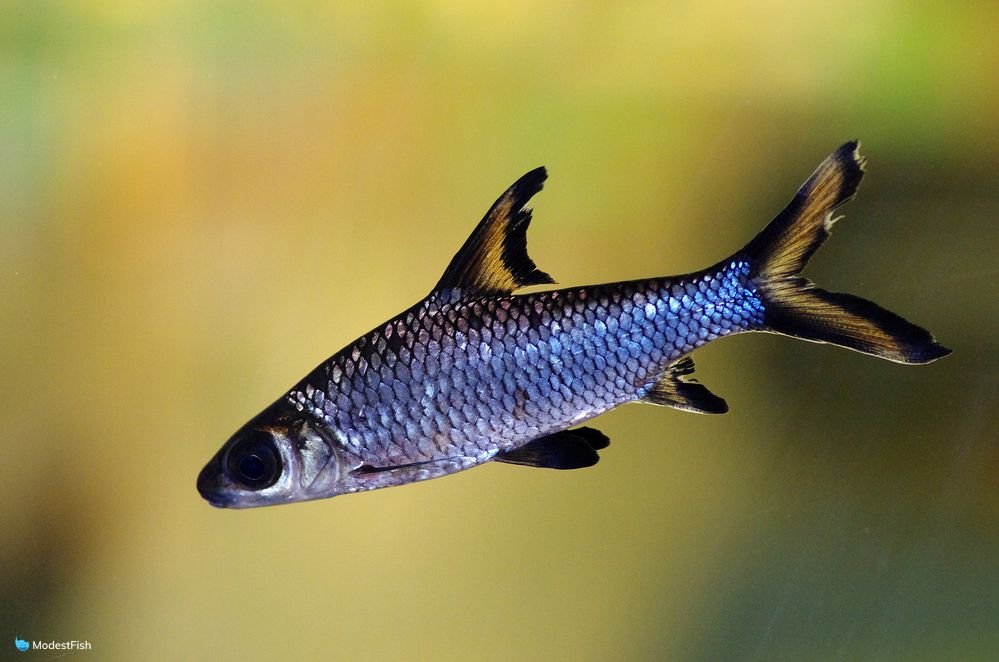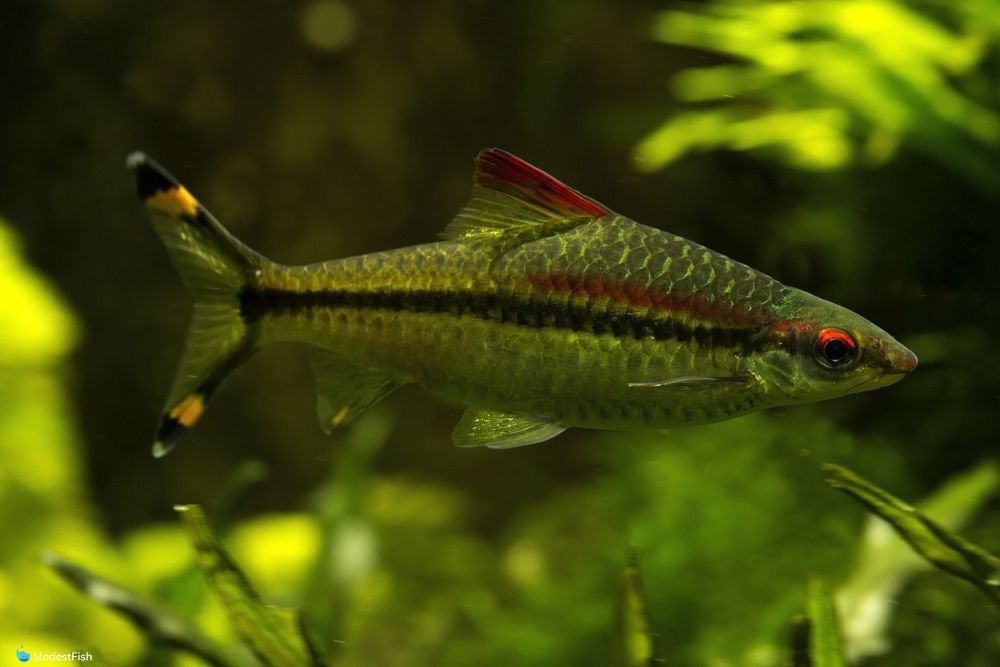I love freshwater aquarium sharks move. Their bodies are flexible and the way their fins dance and move is just beautiful, especially once they’re full size.
I’ve got two rainbow sharks (in separate tanks!), and now that both have reached adulthood, they are so impressive.
And yes. although they’re not technically sharks.. they looks super awesome. Here are my best aquarium sharks you can actually own.
Rainbow Shark (Epalzeorhynchos frenatum)

- Appearance: torpedo-shaped body, body is dark blue black, all fins are bright orange/red
- Min. Tank size: 55 gallon (208 liter)
- Temperature: 72°-82°F (22°-28°C)
- Care level: medium
- Diet: omnivore
- Behavior: aufwuchs eater, aggressive, especially with other rainbow sharks or similar species like red tail sharks
- How many can be kept together: only one per tank
- Size: 6 inches (15 centimeters)
- Status in the wild: Least Concern
This beautiful fish is also something of a bruiser. I really love this species, but they are fairly aggressive and bossy. They’re kinda jerks.
I have one that is just downright evil. Unless fish are five times his size, he will harass and chase them just because they come near. He has taken some nips out of his tank mates’ fins and is super aggressive when it comes to food.
So, your best bet is to create an environment that limits how much the rainbow shark sees the other fish in the tank. If they don’t see the other fish, they don’t chase them.
Make sure to provide this fish with a cave that they can retreat to during the day. Hanging out in a cave makes the rainbow shark feel more secure and it prevents them from interacting with tank mates, so there are fewer opportunities for aggression.
Heavily planting your tank can break up the rainbow shark’s field of vision so it doesn’t see its tank mates as much; this can really cut down on chasing and fin nipping.
I also drop in an algae wafer when I feed the other fish flakes or pellets. That way, the rainbow shark will go after the wafer and doesn’t fight with the other fish over food.
Red Tail Shark (Epalzeorhynchos bicolor)

- Appearance: torpedo-shaped body, body is dark black, caudal fin is bright orange/red
- Min. Tank size: 55 gallon (208 liter)
- Temperature: 72°-79°F (22°-26°C)
- Care level: medium
- Diet: omnivore
- Behavior: bottom feeder, aggressive, especially with other red tail sharks or similar species like rainbow sharks
- How many can be kept together: only one per tank
- Size: 6 inches (15 centimeters)
- Status in the wild: Critically Endangered
The red tail shark is very similar to the rainbow shark in appearance and temperament. But, the red tail shark is more of a bottom feeder, whereas the rainbow shark prefers to munch on algae and aufwuchs.
Just like a rainbow shark, red tails are very bossy and are known to chase tank mates.
You definitely cannot keep more than one in a tank. They will constantly fight with each other, probably until one eventually dies.
They will also attack similar looking species, like rainbow sharks.
Red tail sharks do best with a cave or other hiding spot where they can set up their own territory. Heavily planted tanks break up the fish’s line of sight, lessening aggression.
Bala Shark (Balantiocheilos melanopterus)

- Appearance: torpedo-shaped body, highly reflective silver scales on body, large eyes, black trailing edges on fins and tail
- Min. Tank size: 150 gallon (568 liter)
- Temperature: 72°-82°F (22°-28°C)
- Care level: medium
- Diet: omnivore
- Behavior: active shoaling fish that constantly cruises around in loose groups
- How many can be kept together: does best in a group of five or more
- Size: 14 inches (35 centimeters)
- Status in the wild: Vulnerable
This fish needs to be kept in a school of five or more. Otherwise, they could be very skittish or even aggressive with tank mates. If kept in a big enough group, they will mostly ignore other species of fish.
Bala sharks grow to be very large, often over a foot long. And since they need to be kept in groups, you will need a very large tank to house this species.
Unfortunately, this species is listed as vulnerable. Much like the roseline shark, the bala shark is dwindling in the wild due to overfishing and habitat destruction.
If you have the room, Bala sharks are very impressive. I’ve always enjoyed watching them in large display tanks. Their scales are very reflective and catch the light in brilliant flashes as they swim along.
I also really like that they are a big, impressive fish but aren’t super aggressive like most large cichlids.
Roseline Shark (Sahyadria denisonii)

- Appearance: torpedo-shaped body, dark grey back, silver belly and tail, red stripe runs from nose to dorsal fin, black line runs from nose to tail, caudal fin has bright yellow and black markings
- Min. Tank size: 75 gallon (284 liter)
- Temperature: 60°-77°F (16°-25°C)
- Care level: easy
- Diet: omnivore
- Behavior: active shoaling fish that rapidly darts around the tank
- How many can be kept together: does best in a group of five or more
- Size: 6 inches (15 centimeters)
- Status in the wild: Endangered
A school of these fish is a sight to behold. I was lucky enough to see some of these beauties at A Fish Store in Pensacola, FL.
I’ve got to tell you, they were striking from across the room and drew my eye again and again, even in a room full of gorgeous fish.
This is a shoaling fish that needs to be kept in a group in order to be happy.
They also do best in a long tank versus a tall one. These fish swim close to the bottom, so a tall tank is lost on them. They prefer a tank with a long footprint so they can zip up and down the length of the tank.
Sadly, this fish is endangered in the wild because of habitat destruction and overfishing. If at all possible, try to source fish that are tank bred to avoid further contributing to their decline in the wild.
Okay, They’re Not Technically Sharks
Sorry to disappoint, but these guys aren’t actually tiny sharks, they’re not even closely related to sharks.
But hey, at least you’re safe from shark bites in your home aquarium.
All four species of aquarium freshwater “sharks” actually come from the Cyprinidae family, the carp and minnow family.
So, why’d they all get the name?
These fish do have a silhouette, and a way of moving, that is very reminiscent of actual sharks.
Having kept rainbow sharks for many years, I can definitely tell you that the way their bodies and fins move when they’re active does resemble how sharks move, especially smaller fast moving species like blue sharks.
It’s actually really cool and fun to watch.
Which Freshwater Shark Is Best For You?
So, these guys may not be actual sharks, but they’re still really cool.
I love the way they move, especially the rainbow and red tail sharks. Their bodies are really flexible and the way their fins dance and move is just beautiful, especially once they’re full size.
I’ve got two rainbow sharks (in separate tanks!), and now that both have reached adulthood, they are so impressive.
For the species that are endangered or vulnerable, I would urge you to do your best to only buy tank bred fish. Supporting tank bred fish over wild caught can really make a difference over time.
I hope you find this information helpful.
I wish you and your fish all the best!
